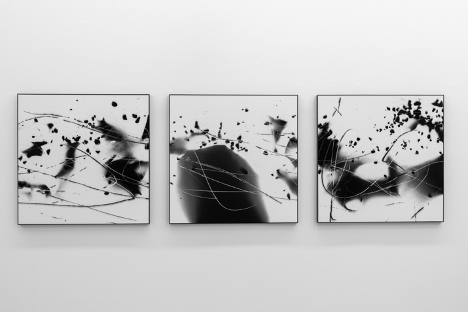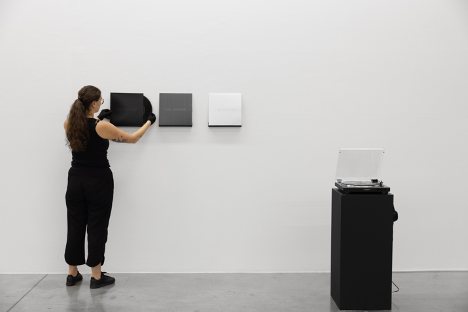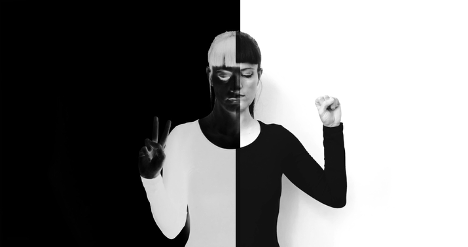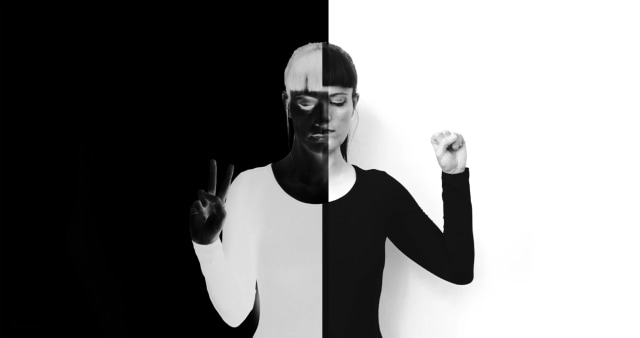Jaroslava Tomanova: Let's talk about sound. Sound seems to be an important focus in this exhibition, including the title pointing towards a sonic pattern. You have used analogue sound media to present digitally generated sound compositions (THE EMPIRE), and a medium format film Washi S designed for recording sound to create black and white photographs representing ungraspable yet impactful processes: The Sound Of Nationalism Going Viral, The Sound Of A Biased Algorithm, The Sound Of A Floating Exchange Rate... (WORLD MUSIC). Could you share a bit more about where your interest in sound comes from and what strategies you used here?
Anahita Razmi: Sound often plays a role within my works, though I rarely set such an explicit focus as in the exhibition "THE RIFF". Yet quite a few works of mine work with strategies of appropriating existing sonic materials, speeches, and songs – for example, in "AAAAAAAAAAAH" or "scroll stock, pluck stock, click stock, drum stock, tap stock, rattle stock".
These works use sonic materials that seem to come with a preset meaning or an inscribed sonic aesthetic: we listen to a melodic pattern or a specific instrument and then often seem to immediately be able to locate and relate it to a context, a time, a 'music style'. We often talk about our visual memory but rarely about our sonic memory when it comes to forms of affect?
In an age completely oversaturated with fast, unambivalent images, listening also proposes a slower form of engagement. I am interested in testing this out, enabling a space in-between image and sound, ear and eye, inward resonance and outward display.
The image series "WORLD MUSIC" uses quite a weird and possibly questionable music category as its title to then test out specific relationships between abstract, virtual 'world events' and their sonic and visual representation. The material I am using for the experimental exposures, the film Washi S, is designed for recording sound yet redeployed for photographic images. It's a sensitive, analogue material that records at high definition; working with it is challenging, beautiful, and unpredictable.

Installation view (left to right): WORLD MUSIC #01 (The Sound Of Something That Is Universal), WORLD MUSIC #02 (The Sound Of A Biased Algorithm), WORLD MUSIC #03 (The Sound Of A Floating Exchange Rate)
On the other hand, the work "THE EMPIRE" works with lyrics of existing national anthems, replacing the anthem melody with generic melodic riffs. The tracks use this form to almost etymologically look at national(ist) language structures, vocabularies and symbolic schemes. At the same time, the repetition of the sonic pattern and the de-personalised, generic voices reciting the anthems produce their own strange effect. There's no climax or expressiveness in this - yet possibly a different kind of seduction.

Installation view: THE EMPIRE (BLACK ALBUM), THE EMPIRE (GREY ALBUM), THE EMPIRE (WHITE ALBUM)
Click here to pre-listen to THE EMPIRE (GREY ALBUM)
JT: Another question that relates to this is about your selection of media and form. Why have you decided to use somewhat old media such as the vinyl record or the medium format film Washi-S? Could you describe the process of deciding and experimenting with the form?
AR: I recently became interested in Wendy Hui Kyong Chun's texts about 'habitual media' in which she writes, "[...]our media matter most when they seem not to matter at all, that is, when they have moved from the new to the habitual". Concerning our use of all our 'media things' every day, I find it interesting to test out what 'old media' can do to question, expose, and disrupt these habits – while simultaneously refusing any kind of nostalgia.
We listen to audio differently when putting on a vinyl record. Taking images on analogue material is an entirely different process than other dominant modes of mass image production today. There's a physicality to these processes, and then I find it interesting to test out what this physicality means when connecting them to the contemporary condition and digital processes. There's definitely no hierarchy nor binary, but a tension between analogue and digital media in "THE RIFF", and the exhibition also includes 3D animation and digital video.
The exhibition also plays with black/white aesthetics as a seemingly binary form, yet it may find its place in the grey shades and gradients.
JT: You seem to be interested in notions such as internationalism or cosmopolitanism, using a reference to the Non-Aligned Movement. I wonder what makes you interested in this movement and how you see its relevance in the city of Dubai, UAE or the Middle East today?
AR: In a way, my interest in the Non-Aligned Movement directly relates to me going back to 'old media'. The Non-Aligned Movement itself doesn't seem to have much significance today; its relevance faded since the end of the cold war around 1989.
And even when the movement was formed, most countries in the Middle East didn't play a significant role; active and influential prominent actors were Global South countries like India, Egypt, Indonesia, and also Yugoslavia. It is interesting, though, that until today the UAE is a member of the Non-Aligned Movement, as are other Arabic states and then also Iran.
Looking at the history of such a movement and its ideas on how "de-ideologisation" and "non-aligned interconnectedness" can de-centre the dominance of global power blocs seems highly relevant today.
My circling around histories and notions of an internationalism and a form of globalisation that is very different from the predominant contemporary neoliberal version of it is linked to these questions. They form part of an ongoing research. I find Naeem Mohaiemen's artistic works on this and his use of archival materials as actors fascinating here.
My video work "I WANNA BE PART OF THE NON-ALIGNED MOVEMENT" uses quite a different and reduced mode of building a relation to archival material, though: it uses a speech by Rajiv Gandhi at the 8th Summit of the Non-Aligned Movement in 1986 and pairs it with a new image of a body split into two non aligned sides. I am curious about what this connection does and how we listen to the words of the speech in this new connection.

Image still from I WANNA BE PART OF THE NON-ALIGNED MOVEMENT
Click here to preview the video.
JT: This relates to my next question, which is about displacing elements of national representation and creating new constellations. In some of your works you use symbols such as flags and anthems and test their meaning when taken out of context, translated, re-staged or blended with something else. Knowing some of your previous works, I believe these playful strategies where you take things literally somehow expose the things you scrutinise and deprive them of their power; in this case, it is a power to build national identities and represent national states. Could you share a bit of the learnings from your experiments of this kind?
AR: When I think of the decline of the idea of non-alignment, I simultaneously need to think of the current rise of national identitarianism, and it makes me shiver. The works want to challenge its logic by destabilising common modes of looking, hearing, and assigning meaning. "THE RIFF" works with existing symbols, but it works to be the opposite of symbolic. "THE RIFF" works with categories of identity and nation, but it works to be the opposite of categorical or identitarian.
I’ve always been excited by the threat, autonomy, and energy that comes with moments of ambiguousness in 'world-making'. The white paper protests in China right now. The complexities of Iranian political opposition as never fitting any classic anti-imperialist discourse. And at the same time, my work is trying to find a contemporary connection to existing poststructuralist and postcolonial ideas here: as in finding moments for de-linking, deconstruction, and disruption that are shifting away from epistemological or structuralist theories of representation.
These moments also need to be aesthetic, I think, and this is a dilemma that interests me.
THE RIFF is on view at CARBON 12 in Alserkal Avenue, Dubai until 5 January 2023.

